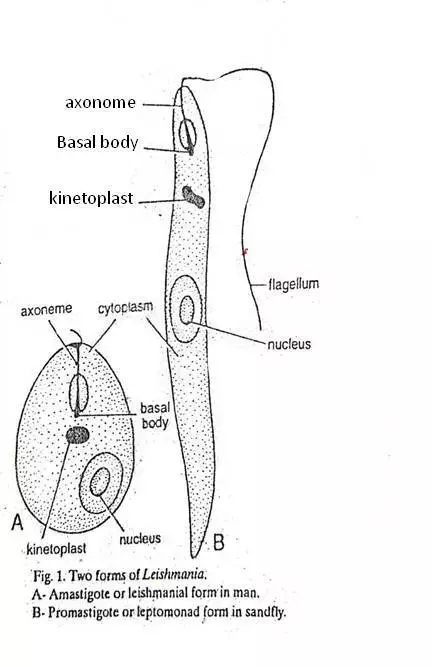In this article, we will learn the morphology or structure of Leishmania donovani. Leishmania donovani is a parasite that causes Visceral Leishmaniasis in humans. It has a characteristic elongated, thin, and spindle-shaped morphology, with a length of around 20-30 μm and a width of 2-5 μm. The parasite has an anterior flagellum, a single nucleus, and a large kinetoplast that contains its DNA.
Diagram

Morphology of Leishmania donovani
1. Shape and Size
-
-
- The Leishmania genus occurs in two forms or stages; leishmanial and leptomonad.
- The leishmanial form is present in the vertebrate (man) and the leptomonad form is present in the invertebrate(sandfly) hosts.
-
a) Leishmanial or amastigote form
-
-
-
-
- It occurs in the vertebrate host or man.
- It is present intracellularly in blood cells or reticulo-endothelial cells of the host.
- It is microscopic and rounded.
- It has a nucleus, blepharoplast, and kinetoplast.
- It has no free flagellum.
- It measures 2µ to 4µ in diameter.
-
-
-
b) Leptomonad or promastigote form
-
-
-
-
- It occurs in the invertebrate host or sandfly.
- It is found in the midgut of the host.
- It is elongated, slender, and spindle-shaped.
- It has a large nucleus, blepharoplast, and kinetoplast.
- It also has a long free flagellum.
- A fully formed leptomonad measures 15-20µ in length and 1-2µ in width.
-
-
-
2. Cell Membrane
-
-
- The whole body is covered externally by firm covering or pellicle.
- It is thin, delicate, and elastic.
- It gives a definite shape to the body.
-
3. Flagellum
-
-
- Leishmania bears only one flagellum. That’s why they are called uniflagellate.
- In the leptomonad form, the flagellum is long and free.
- The flagellum arises from the basal body or blepharoplast.
- The blepharoplast or basal body is situated near the anterior end of the body.
- In the leishmanial form, there is no free flagellum or the flagellum is greatly reduced.
-
4. Cytoplasm
-
-
- Underneath the pellicle, the cytoplasm is present. That means the cytoplasm is covered by the pellicle.
- It is colorless.
- It is not differentiated into ectoplasm and endoplasm.
- The blepharoplast, kinetoplast, rhizoplast, Golgi body, mitochondrion, vacuole and nucleus are present in the cytoplasm.
-
5. Nucleus
-
-
- A single large nucleus is present eccentrically or in the center of the body.
- It is spherical in shape.
- It is vesicular and with a distinct central karyosome or nucleolus.
- It is covered by a double unit membrane with pores and measures about 1µ in diameter.
-
Frequently Asked Questions
Ques 1: What are the two forms of Leishmania donovani?
Ans 1: Leishmanial or amastigote forms and leptomonad or promastigote form.
Ques 2: Do Leishmania have flagella?
Ans 2: The leptomonad form has a flagellum but the leishmanial form doesn’t have any flagella. It uses its flagellum to move.
Ques 3: What is the thread-like structure in Leishmania?
Ans 3: Flagellum.
———- THE END ———–
Read More:
- How do sandflies cause Leishmaniasis?
- Life Cycle of Leishmania donovani | Diagram
- General Characters of All Phylum of The Invertebrates.

Md Ekarm Hossain Bhuiyan is a dedicated zoology graduate with a profound passion for the study of animal life. He completed his primary and secondary education at Ispahani Public School and College, renowned for its commitment to academic excellence. He then pursued his secondary education at Government Science College. After that he achieved graduation at Department of Zoology, Jagannath University. His educational background and enthusiasm for zoology position him to make meaningful contributions to the field of biological sciences in Bangladesh.